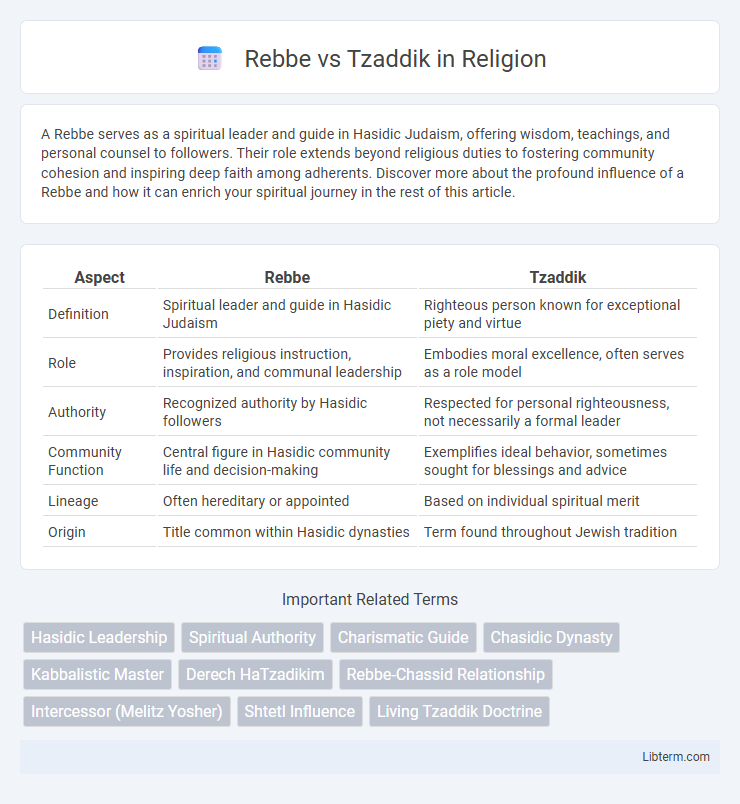A Rebbe serves as a spiritual leader and guide in Hasidic Judaism, offering wisdom, teachings, and personal counsel to followers. Their role extends beyond religious duties to fostering community cohesion and inspiring deep faith among adherents. Discover more about the profound influence of a Rebbe and how it can enrich your spiritual journey in the rest of this article.
Table of Comparison
| Aspect | Rebbe | Tzaddik |
|---|---|---|
| Definition | Spiritual leader and guide in Hasidic Judaism | Righteous person known for exceptional piety and virtue |
| Role | Provides religious instruction, inspiration, and communal leadership | Embodies moral excellence, often serves as a role model |
| Authority | Recognized authority by Hasidic followers | Respected for personal righteousness, not necessarily a formal leader |
| Community Function | Central figure in Hasidic community life and decision-making | Exemplifies ideal behavior, sometimes sought for blessings and advice |
| Lineage | Often hereditary or appointed | Based on individual spiritual merit |
| Origin | Title common within Hasidic dynasties | Term found throughout Jewish tradition |
Defining "Rebbe" and "Tzaddik": Key Differences
A "Rebbe" serves as a spiritual leader and mentor within Hasidic Judaism, providing guidance and teaching to followers, while a "Tzaddik" denotes a righteous individual who embodies exceptional piety and moral integrity. The Rebbe holds an official communal role, often acting as a dynastic figure linking generations, whereas the Tzaddik represents a personal level of holiness that may or may not include leadership responsibilities. Distinction lies in the Rebbe's active pedagogical and communal functions versus the Tzaddik's emphasis on spiritual perfection and ethical conduct.
Historical Origins of Rebbes and Tzaddikim
Rebbes and Tzaddikim both originate from Jewish mystical and Hasidic traditions, with Rebbes emerging primarily in Eastern Europe during the 18th century Hasidic movement led by Rabbi Israel Baal Shem Tov. The role of a Tzaddik, meaning "righteous one," traces back to biblical and Talmudic times as a spiritual leader embodying moral perfection and divine connection. Historically, Rebbes function not only as spiritual guides but also as communal leaders who transmit mystical teachings, whereas Tzaddikim emphasize individual righteousness and God's favor.
Roles and Responsibilities in Jewish Communities
A Rebbe serves as a spiritual leader and mentor in Hasidic communities, guiding followers through religious teachings, personal advice, and communal leadership. A Tzaddik is recognized as a righteous individual whose merit and piety inspire others and often serves as a moral example within broader Jewish society. While the Rebbe actively leads and directs communal practices and spiritual growth, the Tzaddik embodies holiness and ethical conduct, influencing through personal sanctity rather than formal leadership roles.
Spiritual Leadership: Rebbe vs. Tzaddik
A Rebbe serves as a spiritual leader who provides guidance, inspiration, and communal leadership, often acting as a teacher and decisor within Hasidic Judaism. A Tzaddik is revered primarily for personal righteousness and close divine connection, serving as a spiritual exemplar whose sanctity benefits followers through prayer and intercession. Both roles are integral to Jewish spiritual life, with the Rebbe emphasizing communal mentorship and the Tzaddik embodying individual holiness.
Influence and Authority: Contrasting Perspectives
A Rebbe possesses a dynamic spiritual authority rooted in personal guidance and communal leadership, often serving as a direct conduit for divine inspiration within Hasidic communities. A Tzaddik, meanwhile, embodies moral righteousness and spiritual perfection, exerting influence primarily through their exemplary character and piety rather than active leadership roles. This contrast highlights the Rebbe's interactive mentorship versus the Tzaddik's emblematic sanctity as central sources of spiritual influence and authority.
Methods of Guidance and Counsel
A Rebbe offers personalized, spiritual guidance rooted in Hasidic teachings, emphasizing deep metaphysical insights and uplifting the soul. In contrast, a Tzaddik provides counsel through practical righteousness and ethical leadership, often serving as a moral exemplar within the community. Both roles prioritize fostering growth, but the Rebbe's approach is more mystical, while the Tzaddik's is grounded in actionable mitzvot and communal responsibility.
Relationship with Followers: Dynamics and Expectations
A Rebbe cultivates a deeply personal and interactive relationship with followers, often serving as a spiritual mentor who provides individualized guidance and emotional support. In contrast, a Tzaddik is revered primarily for their righteous character and holiness, with followers seeking inspiration and blessings rather than direct personal mentorship. Expectations from a Rebbe include active discipleship and ongoing dialogue, while followers of a Tzaddik typically engage in veneration and emulate their ethical example.
Mystical and Halachic Functions
The Rebbe serves as both a spiritual guide and a mystical conduit within Hasidic tradition, channeling divine energy and providing personal guidance through Kabbalistic insight, while the Tzaddik primarily fulfills Halachic functions by embodying righteousness and serving as a legal authority in Jewish law. Mystically, the Rebbe's role encompasses deep esoteric teachings and active intercession in the spiritual realm, facilitating communal elevation. Halachically, the Tzaddik exemplifies adherence to Torah law and ethical conduct, often acting as a decisor (posek) and exemplar within the legal framework of Judaism.
Rebbe and Tzaddik in Hasidic Tradition
In Hasidic tradition, a Rebbe serves as both a spiritual leader and a mentor, guiding followers through religious teachings and personal growth, while a Tzaddik is revered primarily for their righteousness and spiritual perfection. The Rebbe's role encompasses communal leadership and interpreting mystical teachings, often acting as an intercessor between God and the community. Conversely, the Tzaddik embodies moral exemplarity and divine favor, inspiring through their piety and often serving as a living conduit for divine blessings.
Contemporary Relevance and Evolving Roles
The roles of Rebbe and Tzaddik have evolved significantly in contemporary Jewish life, reflecting shifts in community needs and spiritual guidance. Modern Rebbes often serve as dynamic leaders who combine traditional Torah scholarship with approachable mentorship, addressing contemporary social and ethical challenges. Tzaddikim, while maintaining their foundational role as righteous exemplars and intercessors, increasingly inspire through activism and engagement with broader societal issues, making their spiritual influence more accessible and relevant today.
Rebbe Infographic

 libterm.com
libterm.com